First Barbara of the Day-Barbara Rachko!
Barbara Rachko is an American contemporary artist and author who divides her time between residences in New York City and Alexandria, VA. She is best known for her pastel-on-sandpaper paintings, her eBook, “From Pilot to Painter,” and her popular blog, “Barbara Rachko’s Colored Dust,” which currently has 77,700 subscribers. She is represented by Galleria Balmain (London), Emillions (US), Interstellar (New Delhi), and Galleri SoHo (Sweden).
Barbara has led an extraordinary, inspiring life. She learned to fly at the age of 25 and became a licensed commercial pilot and Boeing-727 Flight Engineer before joining the Navy. As a Naval Officer she spent many years working at the Pentagon and retired as a Commander. On 9/11 her husband, Dr. Bryan C. Jack, was tragically killed on the highjacked plane that crashed into the Pentagon.
Barbara travels regularly to Mexico, Central America, South America, and Asia. In her earlier pastel painting series, “Domestic Threats” and “Black Paintings,” she used her large collection of Mexican and Guatemalan folk art – masks, carved wooden animals, papier mâché figures, and toys – to create one-of-a-kind pastel-on-sandpaper paintings that combined reality and fantasy to depict personal narratives. Since 2017 she has been creating a series called “Bolivianos,” based on an exhibition of Carnival masks she viewed in La Paz, Bolivia.
In 2017 Barbara’s long-standing fascination with traditional masks and indigenous cultures took a leap forward when she visited the National Museum of Ethnography and Folklore in La Paz. One particular exhibition on view, with more than fifty festival masks, was spell-binding. The masks dated from the 1950s and 1960s and were crafted in Oruro, a former tin-mining center about 140 miles south of La Paz. Depicting important figures from Bolivian folklore traditions, the masks were created for use in Carnival celebrations that happen each year in late February or early March.
The annual Carnival celebration in Bolivia is the second largest in the world (after Rio de Janeiro’s). Carnival in Oruro revolves around three great dances. The dance of “The Incas” records the conquest and death of Atahualpa, the Inca emperor when the Spanish arrived in 1532. “The Morenada” dance was once assumed to represent black slaves who worked in the mines, but the truth is more complicated (and uncertain) since only mitayo Indians were permitted to do this work. The dance of “The Diablada” depicts Saint Michael fighting against Lucifer and the seven deadly sins. The latter were originally disguised in seven different masks derived from medieval Christian symbols and mostly devoid of pre-Columbian elements (except for totemic animals that became attached to Christianity after the Conquest). Typically, in these dances the cock represents Pride, the dog Envy, the pig Greed, the female devil Lust, etc.
The La Paz exhibition was stunning and dramatic. Each mask was meticulously installed against a dark black wall and strategically spotlighted so that it seemed alive. Barbara thought the whole effect was uncanny. The masks resembled 3D versions of her “Black Paintings,” a series she had been creating for ten years. She knew immediately that this experience was a gift and spent time composing photographs to use as reference to make paintings when she returned to New York. Consequently, Barbara has enough reference material to create new pastel paintings for years to come. The series, entitled “Bolivianos,” is arguably her strongest and most striking work to date.
Barbara is a master pastel artist who spends months, and hundreds of hours, to create each pastel painting. Here is a description of her self-invented, labor-intensive pastel technique, which she has been refining for approximately 36 years.
To achieve the dark black backgrounds in her “Black Paintings” and “Bolivianos” series, she layers Rembrandt black soft pastel on top of each other. The 400 or 500 grit acid-free sandpaper that serves as her painting support requires at least four layers of black pastel just to achieve even coverage. Over the next few months she adds many more layers of black pastel to achieve the final rich look. The figures and shapes in each pastel painting are a different story. Were you to x-ray them, you’d see many different colors underneath the final one. With each additional pastel layer, she corrects, refines, and strengthens her drawing so the objects depicted become more solid and three-dimensional.
Barbara’s color sense is nuanced and highly developed. In addition to the thousands of pastels she has to choose from - she works with most brands of soft pastel - Barbara layers, mixes, and blends new colors directly on the sandpaper. With each additional pastel layer the colors become more rich and intense. As she works, Barbara searches for the ‘best’ colors, those that make the developing pastel painting on her easel more resonant, alive, and exciting to look at. She loves the challenge of continually improving her craft and demonstrating the limitless possibilities of pastel. Barbara truly is “Revolutionizing Pastel as Fine Art!”
Links: https://barbararachko.art/en/ https://barbararachkoscoloreddust.com/ https://www.instagram.com/barbararachko_artist https://www.facebook.com/BarbaraRachko






Really, really enjoyed reading about this amazing and talented woman!!!
ReplyDeleteMara